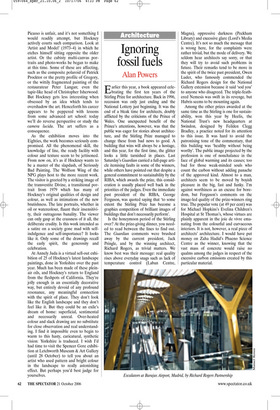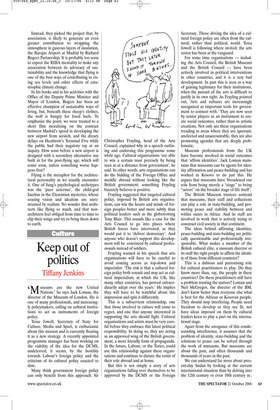Ignoring fossil fuels
Alan Powers
Earlier this year, a book appeared celebrating the first ten years of the Stirling Prize for architecture. Back in 1996, recession was only just ending and the National Lottery just beginning. It was the end of a bleak time for architects, doubly afflicted by the criticisms of the Prince of Wales. One unexpected benefit of the Prince’s attentions, however, was that the public was eager for stories about architecture, and the Stirling Prize managed to change these from bad news to good. A building that wins will always be a hostage, and this year, for the first time, the glitter looks a little tarnished in places. Last Saturday’s Guardian carried a full-page article itemising faults in some of the winners, while others have pointed out that despite a general commitment to sustainability by the RIBA, which awards the prize, this consideration is usually placed well back in the priorities of the judges. Even the immediate past president of the RIBA, George Ferguson, was quoted saying that ‘to some extent the Stirling Prize has become a graphics competition of brilliant images of buildings that don’t necessarily perform’.
Is the honeymoon period of the Stirling over? At the prize-giving dinner, you needed to read between the lines to find out. The Guardian comments were brushed away by the current president, Jack Pringle, and by the winning architect, Richard Rogers, as trivial matters. We know best was their message: real quality rises above everyday snags such as lack of temperature control (Laban Centre, Magna), oppressive darkness (Peckham Library) and excessive glare (Lord’s Media Centre). It’s not so much the message that is wrong here, for the complaints were rather trivial, but the mode of delivery. We seldom hear architects say sorry, or that they will try to avoid such problems in future. Their remarks tend to be more in the spirit of the twice past president, Owen Luder, who famously commended the Richard Rogers design for the National Gallery extension because it said ‘sod you’ to anyone who disagreed. The triple-feathered Nemesis was swift in its revenge, but Hubris seems to be mounting again.
Among the other prizes awarded at the same time as the Stirling is one for sustainability, won this year by Heelis, the National Trust’s new headquarters at Swindon, designed by Feilden Clegg Bradley, a practice noted for its attention to this issue. It was hard to avoid the patronising tone of the commentary, that this building was ‘healthy without being worthy’. The public image projected by the profession is one of nonchalance in the face of global warming and its causes; too bad for those weak-minded souls who count the carbon without adding panache of the approved kind. Almost to a man, architects seem to be moved by boyish pleasure in the big, fast and funky. I’m against worthiness as an excuse for boredom, but Ferguson’s comments on the image-led quality of the prize-winners ring true. The popular vote (at 49 per cent) was for Michael Hopkins’s Evelina Children’s Hospital at St Thomas’s, whose virtues are plainly apparent in the joie de vivre emanating from the colourful and curvaceous interiors. It is not, however, a real piece of architects’ architecture. I would have put money on Zaha Hadid’s Phaeno Science Centre as the winner, knowing that the vast mass of concrete would raise no qualms among the judges in respect of the excessive carbon emissions created by this particular material. Instead, they picked the project that, by association, is likely to generate an even greater contribution to wrapping the atmosphere in gaseous layers of insulation, the Barajas Airport at Madrid by Richard Rogers Partnership. It is probably too soon to expect the RIBA mentality to make any association between its advocacy of sustainability and the knowledge that flying is one of the best ways of contributing to rising sea levels and other effects of catastrophic climate change.
In his books and in his activities with the Office of the Deputy Prime Minister and Mayor of London, Rogers has been an effective champion of sustainable ways of living, but, beneath these sheep’s clothes, the wolf is hungry for fossil fuels. To emphasise the point, we were treated to a short film moralising on the contrast between Madrid’s speed in developing the new airport from scratch, and the dreary delays on Heathrow’s Terminal Five while the public had their nugatory say at an inquiry. How soon before a new airport is designed with a secondary alternative use built in for the post-flying age, which will come soon, unless something worse happens first?
Flying is the metaphor for the architectural personality as we usually encounter it. One of Jung’s psychological archetypes was the ‘puer aeternus’, the child-god Iacchus in the Eleusinian mysteries, whose soaring vision and idealism are unrestrained by realism. No wonder that architects like flying so much, and that nonarchitects feel obliged from time to time to clip their wings and try to bring them down to earth.



































































































 Previous page
Previous page